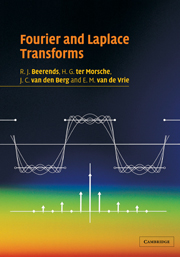Book contents
- Frontmatter
- Contents
- Preface
- Introduction
- Part 1 Applications and foundations
- Part 2 Fourier series
- Part 3 Fourier integrals and distributions
- Part 4 Laplace transforms
- 11 Complex functions
- 12 The Laplace transform: definition and properties
- 13 Further properties, distributions, and the fundamental theorem
- 14 Applications of the Laplace transform
- Part 5 Discrete transforms
- Literature
- Tables of transforms and properties
- Index
14 - Applications of the Laplace transform
Published online by Cambridge University Press: 05 June 2012
- Frontmatter
- Contents
- Preface
- Introduction
- Part 1 Applications and foundations
- Part 2 Fourier series
- Part 3 Fourier integrals and distributions
- Part 4 Laplace transforms
- 11 Complex functions
- 12 The Laplace transform: definition and properties
- 13 Further properties, distributions, and the fundamental theorem
- 14 Applications of the Laplace transform
- Part 5 Discrete transforms
- Literature
- Tables of transforms and properties
- Index
Summary
INTRODUCTION
The greater part of this chapter consists of section 14.1 on linear time-invariant continuous-time systems (LTC-systems). The Laplace transform is very well suited for the study of causal LTC-systems where switch-on phenomena occur as well: at time t = 0 ‘a switch is thrown’ and a process starts, while prior to time t = 0 the system was at rest. The input u(t) will thus be a causal signal and since the system is causal, the output y(t) will be causal as well. Applying the Laplace transform is then quite natural, especially since the Laplace transform exists for a large class of inputs u(t) as an ordinary integral in a certain half-plane Re s > ρ. This is in contrast to the Fourier transform, where distributions are needed more often. For the Laplace transform we can usually restrict the distribution theory to the delta functions δ(t − a) with a ≥ 0 (and their derivatives). As in chapter 10, the response h(t) to the delta function δ(t) again plays an important role. The Laplace transform H(s) of the impulse response is called the transfer function or system function. An LTC-system is then described in the s-domain by the simple relationship Y(s) = H(s)U(s), where Y(s) and U(s) are the Laplace transforms of, respectively, the output y(t) and the input u(t) (compare this with (10.6)).
Information
- Type
- Chapter
- Information
- Fourier and Laplace Transforms , pp. 310 - 336Publisher: Cambridge University PressPrint publication year: 2003
